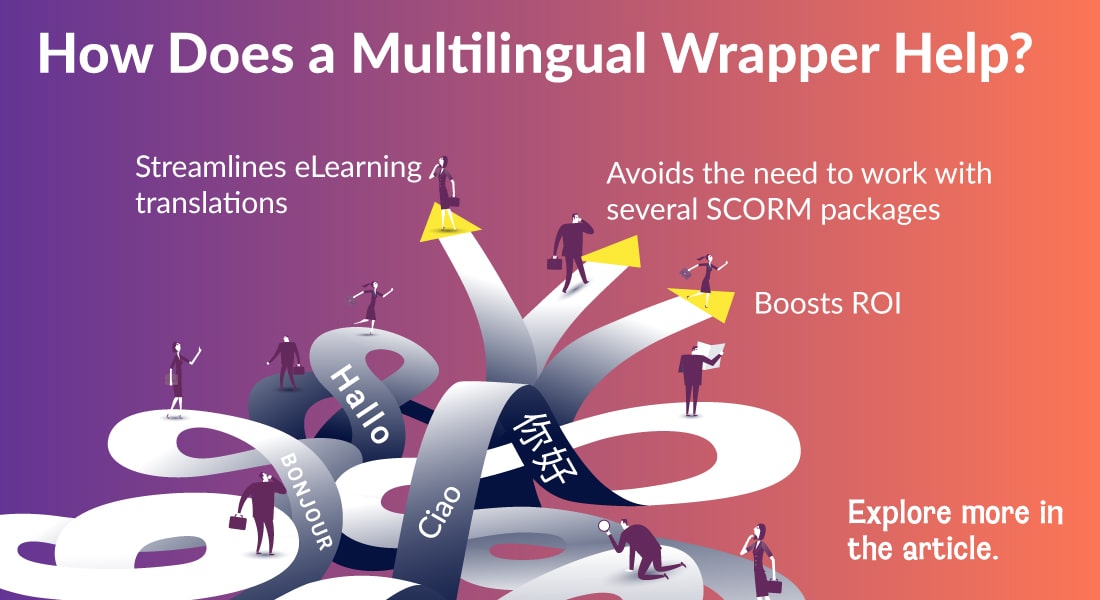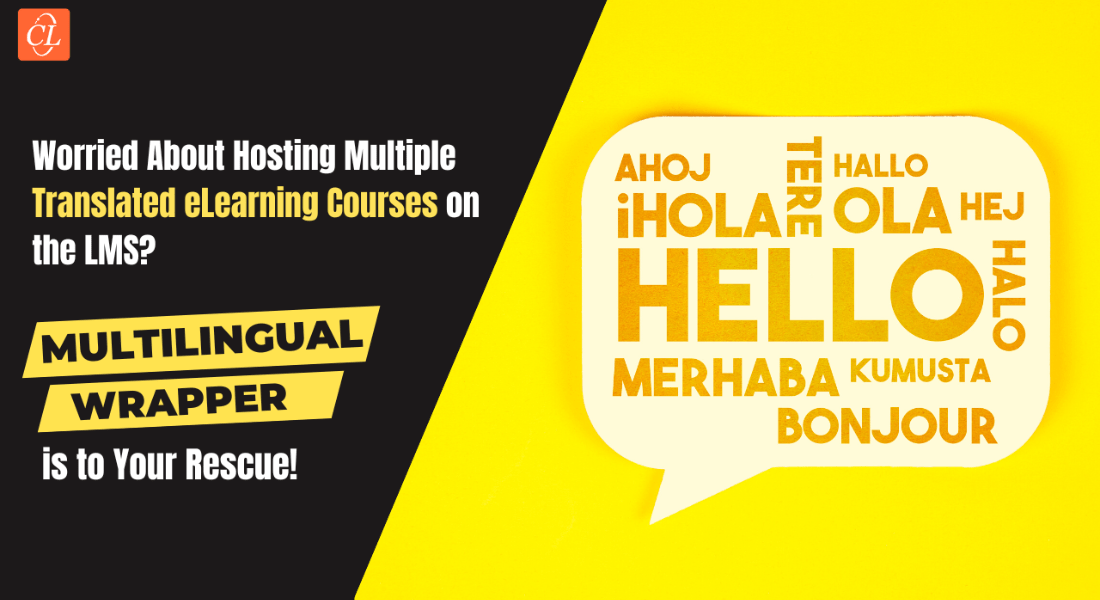Multilingual Wrapper – The Solution to Hosting eLearning Translations in the LMS

One of the most pragmatic ways to provide consistent training to your geographically dispersed, multilingual learners is to translate your eLearning courses. And if you’re worried about the issues with hosting eLearning translations on the LMS, here’s a simple solution – the easy-to-use ‘multilingual wrapper’.
Facing Issues While Hosting eLearning Translations In The LMS? Try Multilingual Wrapper!
Here are a few problems it easily addresses -
- Uploading numerous SCORM packages
- Handling and storing several source files
- Procuring an integrated report for courses in multiple languages
- Switching and accessing courses in multiple languages
- Replacing the revised versions on the LMS
The Need to Leverage the Multilingual Wrapper
We all know that translating the master English eLearning course into desired target languages is a great way of providing effective and consistent training across the organization. But the downside is that you now have multiple versions (in different international languages) of the same course, and the need to host the various translated courses on the LMS (Learning Management Systems)! In this scenario, generating consolidated reports, keeping track of multiple versions (imagine the chaos if you have 30 translations!), or replacing updated versions in the LMS could become a major issue.
→ Download Tool Now: Multilingual Wrapper
The good news is that you can say goodbye to all those LMS challenges once and for all. Wondering how? Well, this is where the ‘multilingual wrapper’ comes to your rescue – promising to resolve all your LMS challenges with translated courses. While we are talking about an LMS, here are a few popular platforms to check out and give a try.
What Exactly is this Multilingual Wrapper?
The Multilingual Wrapper is a very simple-to-use tool that is designed to bring multiple translated versions of an eLearning course together and present them to learners as a single file with all-in-one software. So, you don’t have to juggle between various versions. Isn’t that amazing?
To cut a long story short, your LMS Admin tasks get smoother when you opt for this multilingual wrapper. It is so well customized that even a non-programmer can use it to ‘wrap’ the multilingual versions of a course into a single SCORM package, minimizing duplication and eliminating all confusion for the LMS administrator. Now, let’s take a look at the various issues it addresses.
Frequent LMS Issues and How Multilingual Wrapper Solves Them
The Multilingual Wrapper (also known as Multilingual Shell) is capable of ironing out all your LMS challenges with translated courses. Here are some frequent LMS challenges and the solutions that the multilingual wrapper offers. Before you read about it, here’s a video that will give you a brief idea about the LMS challenges and how multilingual wrapper mitigates them.
1. Uploading Numerous SCORM Packages
Instead of hosting the master course along with all its translated versions in the LMS, your multilingual shell will layer all these versions of the eLearning course in a single SCORM package. That way your LMS administrator doesn’t have to administer multiple language versions of the same course (an arduous task in the best of hands!).
2. Handling and Storing Several Source Files
Your multilingual wrapper places the required source files in the shell, instead of trying to manage the different source files for every language, separately. This makes it easy and faster to identify the source files in the archives.
3. Procuring an Integrated Report for Courses in Multiple Languages
The multilingual wrapper lets you extract consolidated reports on the one course you have hosted in the LMS and simplifies its tracking and reporting. It saves you the bother (and the time and effort) of producing separate reports for each language.
4. Switching and Accessing Courses in Multiple Languages
Earlier, learners who had enrolled in their preferred language at the beginning of the course were not allowed to switch the language mid-way; they had to go through the whole enrollment process again. But with the wrapper, that is no longer an issue. Learners can switch courses flexibly, anytime they want.
5. Replacing the Revised Versions on the LMS
You can avoid the whole time-consuming process of taking-down-a-version-to-upload-another and simply remove and upload the multilingual course shell once. This way, the multilingual shell helps improve the whole learning experience.
How to Use the Multilingual Shell
Don’t worry at all about how to use this multilingual shell, because with this wrapper, housing eLearning translations in the LMS will be a piece of cake. Here are a few translation trends to check out for -
Step 1: Fill in your login credentials through the URL
Step 2: Select the following:
● Course title
● SCORM version
● Authoring tool
● Image for the wrapper’s background
Step 3: Upload eLearning courses as per languages
Step 4: Generate and download the wrapper
Step 5: (Optional) Click to view preview wrappers
See, isn’t the process as easy as pie?
Parting Thoughts!
Now that you are aware of the advantages of the multilingual wrapper, it must be very clear to you that the resolution to all your LMS challenges lies in this ‘multilingual shell’. In a nutshell, it improves the learning experience of your workforce and improves your organization’s ROI. Isn’t this a lifesaver? So bid adieu to your worries and use this effective tool to facilitate the hosting of your eLearning translations in the LMS. Check out these amazing services offered by the multilingual wrapper!
Editor’s note: This post was originally published in November 2021 and has been updated for comprehensiveness.





